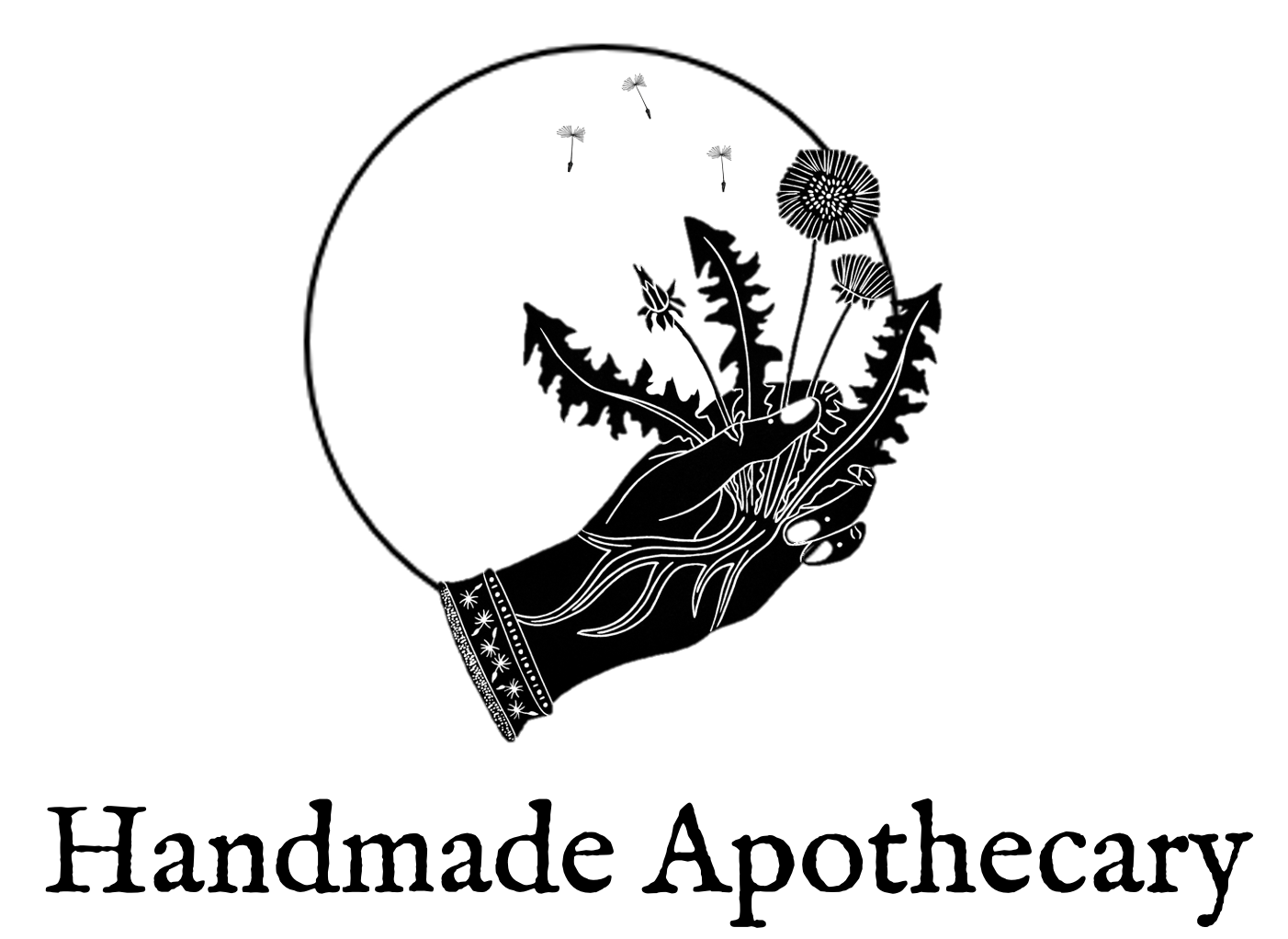How to make herbal cream: Part 2
Components of a cream, clockwise from bottom left: herbal oil, infusion, beeswax, emulsifying wax, finished cream.
This page shares a recipe for making a basic cream and troubleshooting tips. If you haven’t yet, we recommend you read Part 1 on the basics of cream making.
Basic herbal cream recipe
Equipment:
Small scales
Small whisk or electric latte whisk
A jam or digital cooking thermometer
Teapot or infuser to make infusion
Measuring spoons/jugs
2 heatproof jam jars,
A wide pan, with 1-2 inch of water
Empty jar for final product
Blank label
Notebook and pen
Ingredients:
Container 1:
10g beeswax (OR 5g candelilla wax)
10g cocoa butter
50ml herbal-infused oil
Container 2:
50ml herbal infusion or hydrosol(You could also use up to 15ml of the liquid in container 2 as tincture, but the tincture strength must not go over 40% ABV/80 proof))
5g emulsifying wax
Optional extras:
10-20 drops of essential oil of your choice
2-4 teaspoons of aloe vera gel (optional for a lighter cream)
Heat the ‘oil part’ of the recipe, i.e. the beeswax, cocoa butter and infused oil (but NOT the emulsifying wax) together in a heatproof glass jar settled in a pan of about an inch of gently heating water.
In a separate small heatproof jar, gently heat the ‘water parts’ of your recipe, i.e. tincture and infusion together. Add the emulsifying wax to the infusion/tincture pan and leave it to melt.
Remove both mixtures from the heat, and measure the temperature using a jam thermometer to make sure they are at a similar level, though the water part can be up to 10 degrees hotter than the oil. If you don’t have a thermometer, you can leave them both to cool to a bit, ideally just above blood/body temperature. Use a finger to check both mixtures are similar temperatures (Caution: make sure it won’t be too hot by touching the outside of the jar first). The infusion mix may cool a little quicker; if so, return it briefly to the heat.
When they are both similar temperatures, you can start mixing them together. You will add the water mixture slowly to the oil mixture.
Little by little (a few drops a time) pour the infusion/tincture mix into the oil container, whisking quickly (a handheld electric ‘latte’ whisk works best) until thoroughly combined. As it mixes and cools, a creamy consistency will be produced.
Spoon into sterilised jars, then seal, label and date. For external use only.
OPTIONAL EXTRAS:
For extra preservation and herbal healing, 10-20 drops of essential oil can be stirred in well after the cream is made.
This cream is quite rich. If you prefer a lighter cream, you can gently fold in 50 ml of aloe vera gel after it is completed. You can even stir in a little extra tincture and infused oils as needed.
SHELF LIFE: Keep in the fridge for up to 6 months.
Troubleshooting
My cream is too runny
Well, this is the question of the century. The most likely scenarios are: 1) the oil and water bases weren’t kept at a similar temperature while mixing, 2) You added the oil and water parts to each other too quickly. Try again but slower 3) you mis measured one of the ingredients, 4) you added the oil to the water part when you should have added the water into the oil part, 5) Sometimes it just happens, it happens to all of us. Sometimes the chemistry in certain herbal tinctures and oils makes the recipe just not work. If the cream stayed runny and hasn’t split or curdled, just call it a lotion and it will still have the same lovely herbal properties. If it has split or curdled, just pop it on the compost heap and try try again. Always write down successful recipes and get swapping with others, and experiment, experiment, experiment.
Check out this video to learn about thickening creams.
My cream separated/split
See items above, as these are common causes of splitting too. Other issues may have come from 1) not a stable recipe, try a different one, 2) Sometimes higher alcohol tinctures cause separation (so stick to the 30/35% tinctures, (If you are using higher then you are likely trying to use resinous tinctures e.g. Frankincense, try using it as an essential oil instead) 3) adding a preservative after the cream was made. Sometimes these split creams. Try a different preservative. 4) you used a recipe with not enough emulsifier.
Sometimes some of the tincture may ‘fall out’ of the cream, but the cream does not actually separate: You end up with a great cream and a little tincture hanging around the bottom. Let the cream set, then gently stir the tincture back in to it and this should sort it.
Check out this video to learn about fixing separation.
My cream set then went runny again
When you make a cream and whisk it, once it starts to set, whisk a little slower and then stop. If you over whisk, you can split the cream (just like in mayonnaise) and it will go runny again. You will have to make a new one.
My cream went mouldy
Creams have about 3 to 6 months shelf life depending on climate. Keep in the fridge for prolonged life span. If your cream went mouldy too quickly, remember you are making natural products, and this is nature’s way. Try using a preservative (available from suppliers) if you want longer term use.


